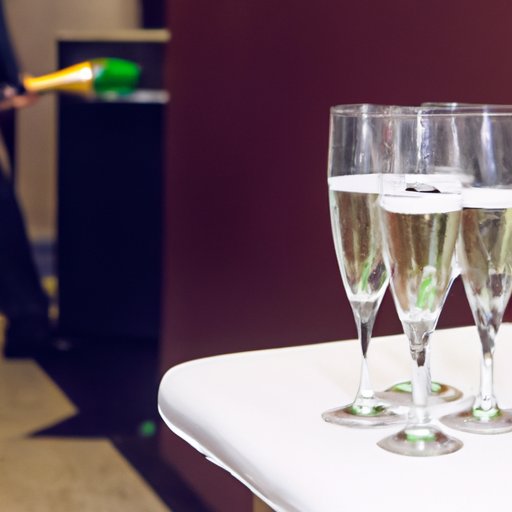I. Introduction
When it comes to serving champagne, many people wonder how many glasses they can get out of a single bottle. Knowing the answer to this question is not only important for planning events or parties, but also for ensuring you have enough champagne for any occasion. Below we’ll break down the facts on how many glasses are in a champagne bottle and provide you with a guide to serving champagne like a pro.
II. Breaking down the facts: How many glasses can you really get out of a champagne bottle?
Champagne is a specific type of sparkling wine that comes from the Champagne region of France. Unlike other sparkling wines, Champagne has strict requirements regarding its production and origin, which contributes to its unique taste and character.
Champagne bottles also come in various shapes and sizes, each with its own unique characteristics and specifications. A standard Champagne bottle size is 750 ml, which is equivalent to around 25 fluid ounces or just over 5 glasses of wine.
However, the number of glasses that can be filled per bottle depends on the size of the glass and how full each glass is poured. On average, you can get around 4-5 glasses of Champagne from a standard 750 ml bottle.
III. The ultimate guide to serving Champagne: Understanding the glass-to-bottle ratio
When it comes to serving Champagne, the standard serving size is around 4-6 ounces per glass. This means that for a bottle of Champagne, you can expect to serve around 4-5 people depending on their consumption. It’s important to keep in mind the glass-to-bottle ratio when planning an event or party to ensure you have enough Champagne to go around.
To calculate the number of bottles required for an event, consider factors such as the number of guests, the amount of Champagne you anticipate each guest consuming, and the duration of the event.
IV. Champagne math 101: Calculating the number of glasses in a bottle
To get a more exact number of glasses you can pour from a Champagne bottle, you will need to do some simple math.
First, determine the number of ounces of Champagne in a bottle. As mentioned earlier, a standard 750 ml Champagne bottle contains approximately 25 ounces of Champagne. Next, divide this number by the number of ounces you plan to serve per glass (4-6 ounces per glass). This will give you the approximate number of glasses you can get per bottle.
It’s worth noting that if you pour smaller amounts of Champagne in each glass, you can get more glasses per bottle.
V. From flutes to coupes: Maximizing your champagne servings
The type of glassware you use to serve Champagne can also impact the number of glasses you can get from a bottle. The most common styles used for Champagne are flutes and coupes.
Flute glasses tend to have narrower openings and taller stems, which can help to preserve the carbonation and aroma of the Champagne. However, they also have a smaller volume capacity, meaning you may need to refill more frequently. Coupes, on the other hand, have a wider bowl and can hold more Champagne at once, but it’s easier to lose carbonation due to the wider opening.
Ultimately, it comes down to preference and occasion. If you’re looking to maximize your Champagne servings, consider using a smaller flute, as smaller pours will give you more glasses per bottle.
VI. Sipping or sharing? A closer look at champagne pours and bottle sizes
Champagne bottles come in a wide range of sizes beyond the standard 750 ml bottle. The common Champagne bottle sizes are:
- Magnum (1.5 L) – equivalent to two standard 750 ml bottles
- Jeroboam (3 L) – equivalent to four standard 750 ml bottles
- Methuselah (6 L) – equivalent to eight standard 750 ml bottles
- Salmanazar (9 L) – equivalent to twelve standard 750 ml bottles
- Balthazar (12 L) – equivalent to sixteen standard 750 ml bottles
- Nebuchadnezzar (15 L) – equivalent to twenty standard 750 ml bottles
As you can imagine, the larger the bottle, the more glasses you can fill. However, larger bottles can also be more difficult to pour, store, and chill.
VII. The truth about Champagne servings: Debunking common myths and misconceptions
There are many myths surrounding the art of serving Champagne, some of which are believed to impact the number of glasses you can get per bottle. For example, some people believe that the temperature of the Champagne or the type of cork used can affect the number of glasses you can get per bottle. However, the temperature and type of cork do not have a significant impact on the number of glasses you can serve per bottle.
It’s essential to understand that the number of glasses per bottle varies depending on factors that include the size of the bottle, glassware used, and the volume of champagne poured into each glass. Knowing this will ensure that you can serve the correct amount of Champagne per person or occasion without sacrificing quality or quantity.
VIII. Conclusion
Now, you’re equipped with the knowledge to serve Champagne like a pro! Understanding how many glasses are in a Champagne bottle is essential when planning events, parties, or for any festive occasion. By following our guide, you can be sure to calculate the number of bottles you need accurately, select the right glassware, and maximize your servings, leading to a memorable and enjoyable experience for you and your guests.
